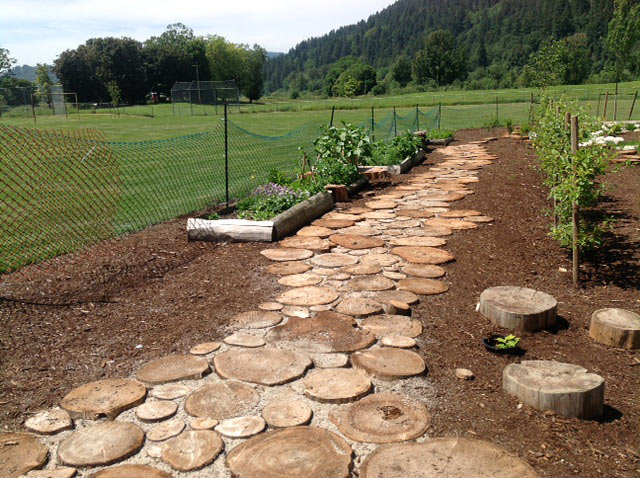Nestled in the heart of the Fraser Valley lies the small rural community of Dewdney. Three years ago, declining enrollment threatened the future of the community’s only school, but today, Dewdney Elementary has become a shining example of how re-creating outdoor space can strengthen student learning and bring together a community. Led by the vision of their Principal, Mrs. McLeod, and the implementation of the Community Outdoor Recreation and Environmental Education (CORE) program, this small school has been hugely successful in incorporating environmental education, stewardship and restoration into everyday learning.
The school transformed a soggy field of grass into a naturalized area full of opportunities for play, growth and learning. Students participated in the design and construction of various features, including a “mud kitchen” and garden boxes for growing food. They also planted and cared for fruit trees, edible berry bushes and other native plants. A wooden tree-cookie pathway leads the young learners through the landscape, past apple trees and strawberry plantings into a free play area with loose natural materials for making whatever the students can imagine come to life. Not without modern conveniences, the site also boasts rainwater harvesting, biofiltration swales, and a power-generating windmill for a covered shelter appropriately named “the Den”.

Teachers at Dewdney have used the concepts from HCTF’s Wild Schools and the Get Outdoors resources to augment the student’s use of the learning area during free time, as well as more deeply infusing it into the learning process while doing inquiry based work and while planting and maintaining the planter boxes. Using a GO Grant, classes were able to create and nurture food gardens including a three-sisters planting concept of beans, corn and squash . In the fall, they will harvest, prepare and preserve their garden’s bounty with the help of community partners.
Experiences in the outdoor space integrate curriculum concepts of numeracy, language, science and physical education. Students learn from their successes and also failures; they’ve witnessed some of their gardening work quickly undone by nighttime critters, and gained an understanding of the interactions between plants and wildlife in the process. Seeds that fail to sprout prompt questions as to why, providing an opportunity for inquiry-based learning. These experiences are only the beginning; Dewdney’s efforts to integrate ecology and stewardship into student learning recently won them $25,000 of technology from Staples to help further their environmental and educational programs. These include restoring and expanding a wetland are covered in invasive reed canary plants and the addition of a large greenhouse.
While replicating the success of Dewdney Elementary’s schoolyard transformation may seem daunting to those starting with a blank schoolyard canvas, Dewdney’s administration encourages interested schools to start small and build as you grow. “Our project and any successes that come along with it, are the result of teachers, parents, community members, businesses working together to make a difference in their corner of the world,” says Sue McLeod, the school’s principal. “It is not the size of the project that is important, but the willingness to jump in and get their hands dirty. That is the most fun of all!”
Thanks to WildBC facilitator Lisa Fox for sharing this story with us! For more information on HCTF Education’s projects and programs, visit hctfeducation.ca
UPDATE: Read about how Dewdney Elementary School is making their school yard even greener through the HCTF-funded Wetlands Institute.







